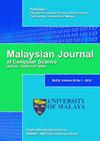基于深度学习的新型冠状病毒肺炎x射线图像三类与四类自动分类的比较研究
IF 1.2
4区 计算机科学
Q4 COMPUTER SCIENCE, ARTIFICIAL INTELLIGENCE
引用次数: 0
摘要
新冠肺炎病毒的传染率高于来自同一家族的MERS-Cov和SARS-Cov病毒,该病毒被评估为在2019年最后几个月从动物传染给人类。高传染率导致新冠肺炎病毒迅速传播到世界各国。为了控制新冠肺炎病毒的传播,能够快速发现病例是非常重要的。因此,开发基于X射线、CT扫描和超声图像的人工智能方法自动诊断新冠肺炎的系统是一个紧迫而不可或缺的需求。为了增加研究中使用的X射线图像的数量,通过组合八个不同的数据集创建了一个混合数据集,从而最大限度地扩大了研究范围。在这项研究中,共使用了9667张X射线图像,包括3405份新冠肺炎样本、2780份细菌性肺炎样本、1493份病毒性肺炎样本和1989份健康样本。在这项旨在使用X射线图像诊断新冠肺炎疾病的研究中,使用两种不同的分类结构进行了自动分类:新冠肺炎肺炎/其他肺炎/健康和新冠肺炎肺炎/细菌性肺炎/病毒性肺炎/健康。卷积神经网络是一种成功的深度学习方法,在研究中被用作分类器。总共使用了七种CNN架构:Mobilenev2、Resnet101、Googlenet、Xception、Densent201、Efficientnetb0和Inceptionv3架构。从原始X射线图像中获得分类结果,并使用局部二值模式和局部熵获得图像。然后,使用流水线算法从获得的结果中计算出新的分类结果。获得了符合研究范围的详细结果。根据所进行的实验结果,用于三类和四类自动分类的三种最成功的CNN架构分别是Densenet201、Xception和Inceptionv3。此外,据了解,研究中使用的流水线算法对改进结果非常有用。研究结果表明,在一些比较参数上实现了高达1.57%的改进。本文章由计算机程序翻译,如有差异,请以英文原文为准。
A NOVEL COMPARATIVE STUDY FOR AUTOMATIC THREE-CLASS AND FOUR-CLASS COVID-19 CLASSIFICATION ON X-RAY IMAGES USING DEEP LEARNING
The contagiousness rate of the COVID-19 virus, which was evaluated to have been transmitted from an animal to a human during the last months of 2019, is higher than the MERS-Cov and SARS-Cov viruses originating from the same family. The high rate of contagion has caused the COVID-19 virus to spread rapidly to all countries of the world. It is of great importance to be able to detect cases quickly in order to control the spread of the COVID-19 virus. Therefore, the development of systems that make automatic COVID-19 diagnoses using artificial intelligence approaches based on Xray, CT scans, and ultrasound images are an urgent and indispensable requirement. In order to increase the number of X-ray images used within the study, a mixed data set was created by combining eight different data sets, thus maximizing the scope of the study. In the study, a total of 9,667 X ray images were used, including 3,405 of COVID-19 samples, 2,780 of bacterial pneumonia samples, 1,493 of viral pneumonia samples and 1,989 of healthy samples. In this study, which aims to diagnose COVID-19 disease using X-ray images, automatic classification has been performed using two different classification structures: COVID-19 Pneumonia/Other Pneumonia/Healthy and COVID-19 Pneumonia/Bacterial Pneumonia/Viral Pneumonia/Healthy. Convolutional Neural Networks (CNNs), a successful deep learning method, were used as a classifier within the study. A total of seven CNN architectures were used: Mobilenetv2, Resnet101, Googlenet, Xception, Densenet201, Efficientnetb0, and Inceptionv3 architectures. The classification results were obtained from the original X-ray images, and the images were obtained by using Local Binary Pattern and Local Entropy. Then, new classification results were calculated from the obtained results using a pipeline algorithm. Detailed results were obtained to meet the scope of the study. According to the results of the experiments carried out, the three most successful CNN architectures for both three-class and four class automatic classification were Densenet201, Xception, and Inceptionv3, respectively. In addition, it is understood that the pipeline algorithm used in the study is very useful for improving the results. The study results show that up to an improvement of 1.57% were achieved in some comparison parameters.
求助全文
通过发布文献求助,成功后即可免费获取论文全文。
去求助
来源期刊

Malaysian Journal of Computer Science
COMPUTER SCIENCE, ARTIFICIAL INTELLIGENCE-COMPUTER SCIENCE, THEORY & METHODS
CiteScore
2.20
自引率
33.30%
发文量
35
审稿时长
7.5 months
期刊介绍:
The Malaysian Journal of Computer Science (ISSN 0127-9084) is published four times a year in January, April, July and October by the Faculty of Computer Science and Information Technology, University of Malaya, since 1985. Over the years, the journal has gained popularity and the number of paper submissions has increased steadily. The rigorous reviews from the referees have helped in ensuring that the high standard of the journal is maintained. The objectives are to promote exchange of information and knowledge in research work, new inventions/developments of Computer Science and on the use of Information Technology towards the structuring of an information-rich society and to assist the academic staff from local and foreign universities, business and industrial sectors, government departments and academic institutions on publishing research results and studies in Computer Science and Information Technology through a scholarly publication. The journal is being indexed and abstracted by Clarivate Analytics'' Web of Science and Elsevier''s Scopus
 求助内容:
求助内容: 应助结果提醒方式:
应助结果提醒方式:


